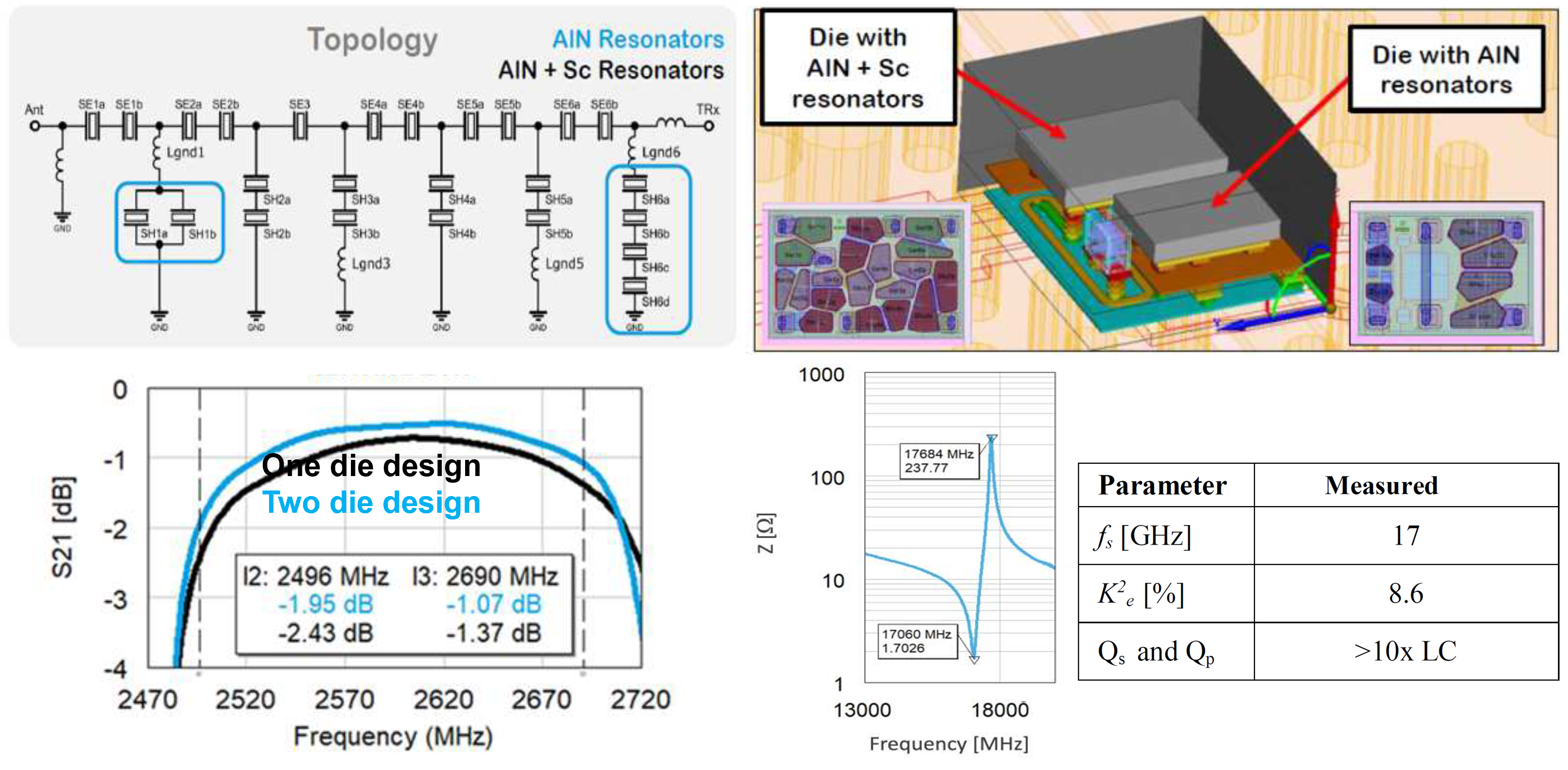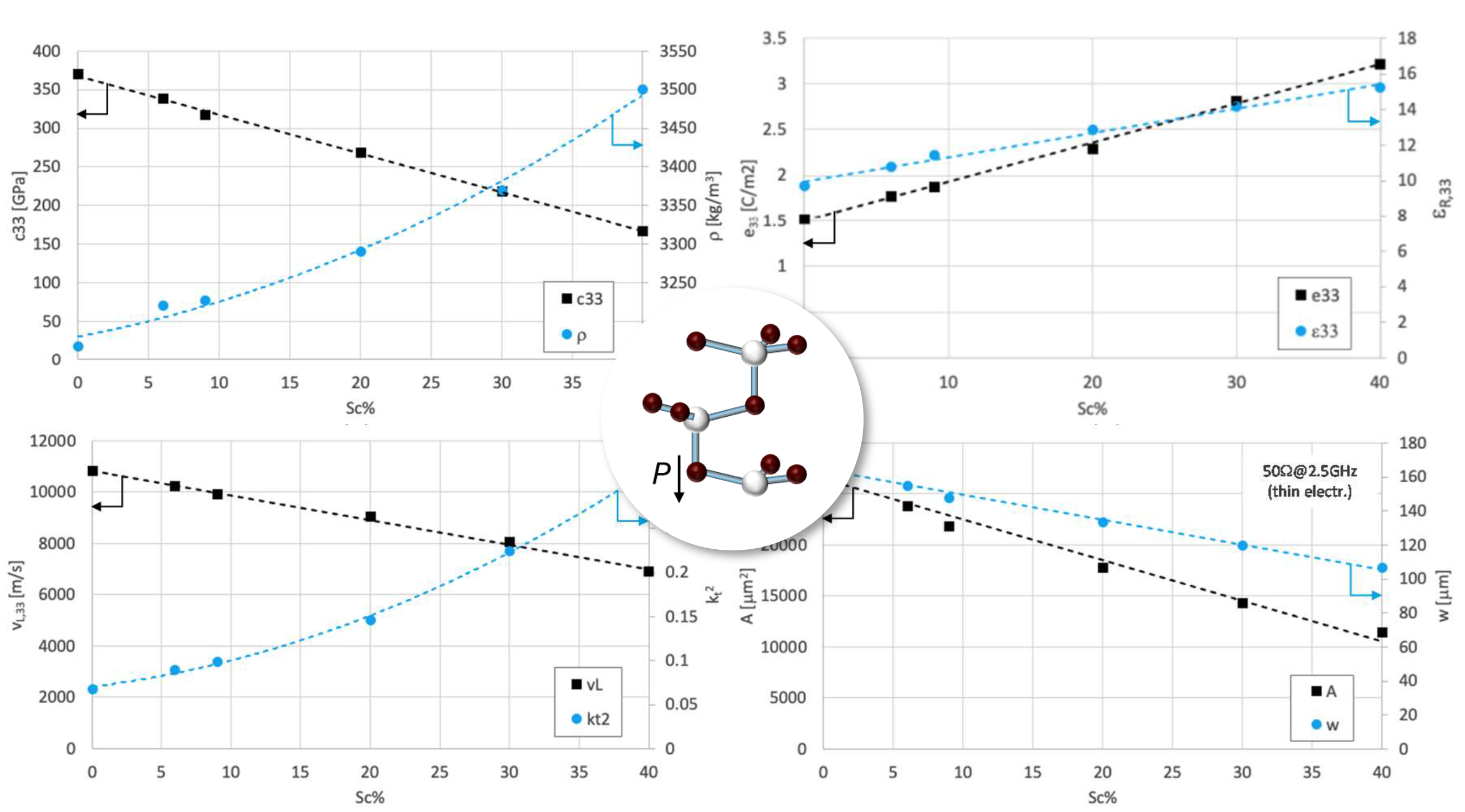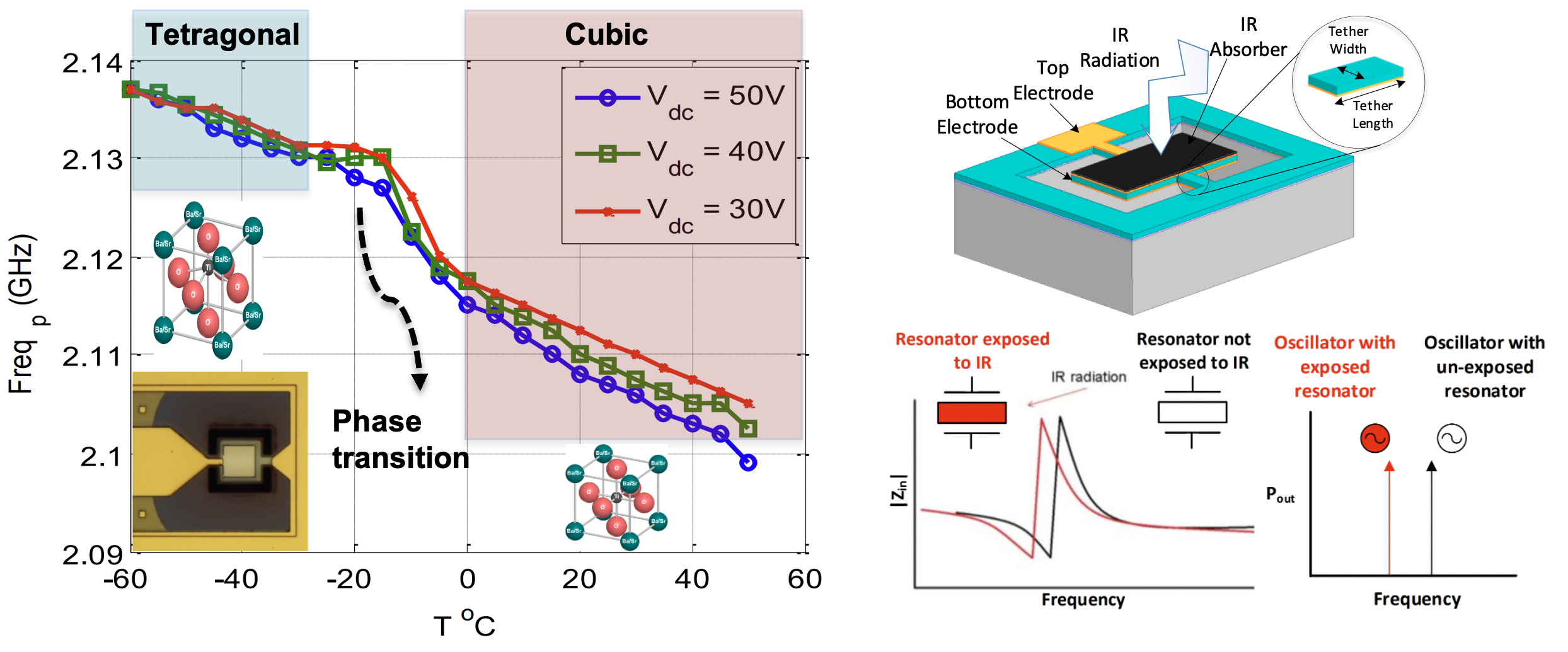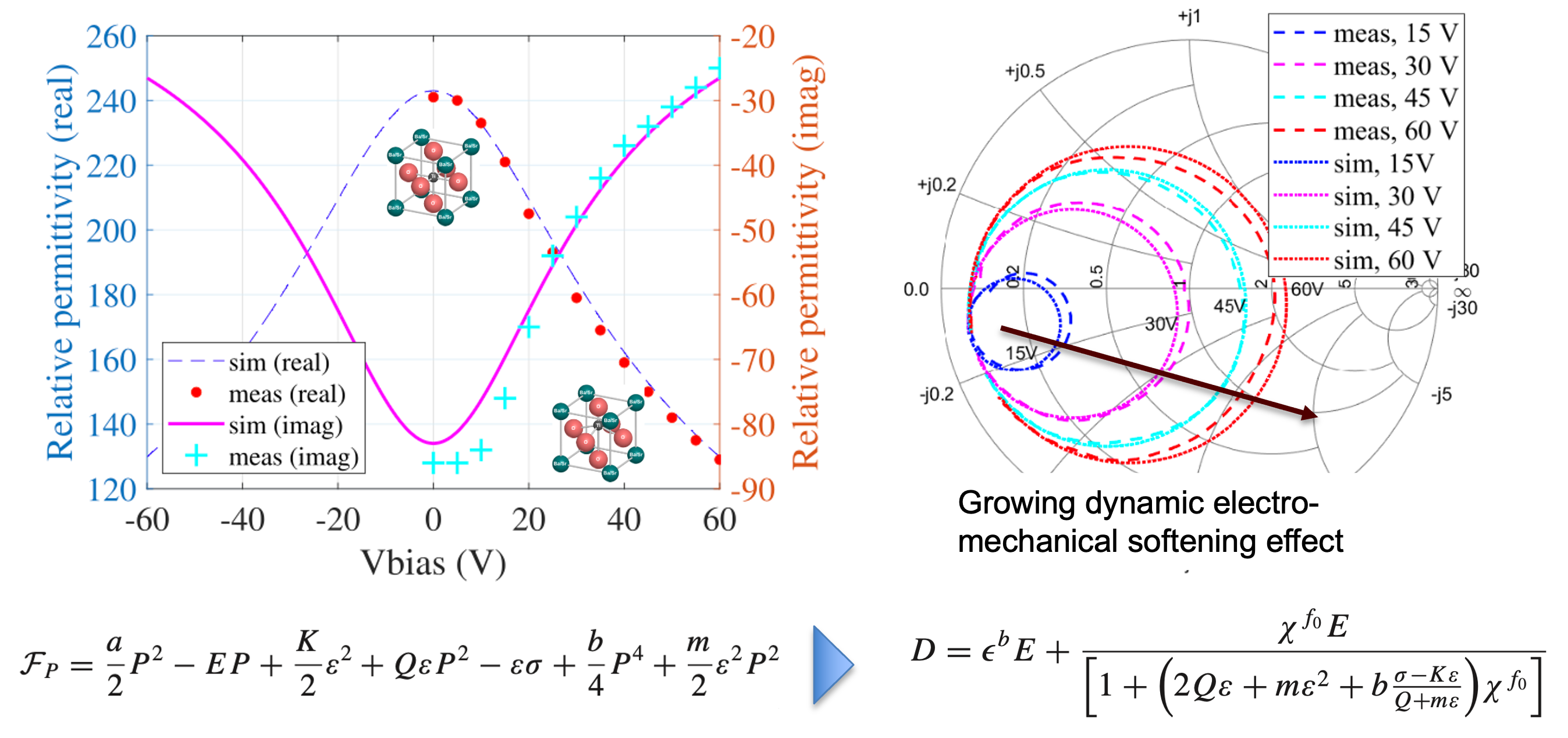Our research focuses on developing advanced materials and micro/nano-manufacturing techniques to enable novel device physics and integrated systems that address critical challenges in high-speed communications and sensing technologies.
Current Activities
I. Material and Process Layer:
Multifunctional Materials:
-
III-V: Piezoelectric/Ferroelectric AlXN
- more details coming soon!
-
Ferroelectric Oxides: BaTiO3, BST, HfO2
- more details coming soon!
- more details coming soon!
-
HAMIP: Hybrid Additive-Bonding Multidimensional Heterogenous Integration Platform
- more details coming soon!
II. Application Layer:
High-Speed Microelectronics and Micro/Nano-systems:
-
Electromagnetic & Acoustic Integrated mm-Wave and THz Devices and Circuits
- more details coming soon!
-
Nonlinear and Nonreciprocal RF Devices (<30 GHz)
- more details coming soon!
-
Reconfigurable EM Metasurfaces
- more details coming soon!
Quantum Microsystems:
-
Quantum Oscillators (Clocks)
- more details coming soon!
Integration and Packaging:
-
3D RF Front-Ends with Functional Packaging
- more details coming soon!
Past Projects:
[Material, Process, Device, System] Enabling 5G-Advanced: Microwave & mmWave Acoustic Microsystems Employing ScAlN
 Our research has advanced Bulk Acoustic Wave (BAW) technology employing scandium-doped aluminum nitride (ScAlN) while at Qorvo, enabling record-setting acoustic resonators and filters performance beyond 10 GHz, crucial for 5G-Advanced and WiFi. Key achievements include resonators demonstrating over 100% improvement in quality factor (Q), more than 50% reduction in the temperature coefficient of frequency (TCF), and significant enhancements in power handling and insertion loss (IL). Furthermore, through innovative multi-chip heterogeneous integration—combining ScAlN and AlN resonators on multiple dies—we have achieved exceptional filter performance characterized by improved insertion loss, superior out-of-band rejection, and significantly reduced die sizes (up to 50% smaller). These advancements collectively meet the stringent requirements of next-generation wireless RF front-end modules operating at microwave and millimeter-wave frequencies
Our research has advanced Bulk Acoustic Wave (BAW) technology employing scandium-doped aluminum nitride (ScAlN) while at Qorvo, enabling record-setting acoustic resonators and filters performance beyond 10 GHz, crucial for 5G-Advanced and WiFi. Key achievements include resonators demonstrating over 100% improvement in quality factor (Q), more than 50% reduction in the temperature coefficient of frequency (TCF), and significant enhancements in power handling and insertion loss (IL). Furthermore, through innovative multi-chip heterogeneous integration—combining ScAlN and AlN resonators on multiple dies—we have achieved exceptional filter performance characterized by improved insertion loss, superior out-of-band rejection, and significantly reduced die sizes (up to 50% smaller). These advancements collectively meet the stringent requirements of next-generation wireless RF front-end modules operating at microwave and millimeter-wave frequencies
A. Tag et al., “Next Generation Of BAW: The New Benchmark for RF Acoustic Technologies,” IEEE IUS, 2022, doi: 10.1109/IUS54386.2022.9958625
A. Tag, et al., “Advances in BAW Technology Enabling 5G NR and WiFi6E,” 2024 IEEE UFFC-JS, 2024, doi: 10.1109/UFFC-JS60046.2024.10793499
[Material, Process] Scandium-doped AlN (ScAlN): Understanding the Coupled Electro-Mechanical Domains
 Incorporating scandium into aluminum nitride (ScAlN) fundamentally modifies the material’s electromechanical coupling, acoustic velocities, dielectric properties, and piezoelectric response, introducing pronounced ferroelectric-like behaviors and complex coupled-domain interactions. Our research at Qorvo addressed these complexities through precise material characterization and innovative material-process techniques, including optimized Sc doping control, uniform film deposition, and precision etching processes. These process innovations are coupled with detailed finite-element modeling (FEM) and boundary engineering, systematically mitigating edge-related spurious modes and maintaining resonator quality factor (Q). Through a deeper understanding of material behavior and advanced fabrication methodologies, our approach effectively manages these coupled-domain phenomena, resulting in ScAlN resonators optimized for stable, reliable, and high-performance RF acoustic applications
Incorporating scandium into aluminum nitride (ScAlN) fundamentally modifies the material’s electromechanical coupling, acoustic velocities, dielectric properties, and piezoelectric response, introducing pronounced ferroelectric-like behaviors and complex coupled-domain interactions. Our research at Qorvo addressed these complexities through precise material characterization and innovative material-process techniques, including optimized Sc doping control, uniform film deposition, and precision etching processes. These process innovations are coupled with detailed finite-element modeling (FEM) and boundary engineering, systematically mitigating edge-related spurious modes and maintaining resonator quality factor (Q). Through a deeper understanding of material behavior and advanced fabrication methodologies, our approach effectively manages these coupled-domain phenomena, resulting in ScAlN resonators optimized for stable, reliable, and high-performance RF acoustic applications
[Process, Device] Programmable RF Acoustics Realized by Nonlinear Inhomogeneous Transduction Medium
We introduced a new class of programmable RF acoustic devices by exploiting the nonlinear electrostrictive responseof ferroelectric thin films, using engineered heterostructures of barium strontium titanate (BaₓSr₁₋ₓTiO₃, BST) to enable field-defined electromechanical transduction. In contrast to fixed-response piezoelectric systems, BST allows for electric-field-induced piezoelectricity, offering dynamic control over mode excitation and coupling strength within a single resonator.
At the heart of this platform is the design of ferroelectric heterostructures composed of multiple functional layers, where material composition, interface configuration, and residual stress are tuned to stabilize the centrosymmetric cubic phase, enhance dielectric linearity, and suppress extrinsic energy dissipation. These stacks were fabricated through process-controlled thin-film deposition and annealing, allowing for precise manipulation of polarization dynamics and acoustic impedance matching across layers.
To describe and optimize the resulting devices, we developed a nonlinear electro-mechanical model that captures field-induced polarization, dynamic compliance, and harmonic coupling. This model was calibrated and validated through experimental measurements of bias-dependent frequency response, enabling predictive tuning of modal behavior and electro-mechanical coupling (Kt²). The interplay between structure and field distribution allows selective excitation of higher-order modes with minimal degradation in coupling—circumventing the conventional 1/n² decay.
This framework led to the implementation of the first band-switchable ladder-type filter based on intrinsic modal programmability, where distinct acoustic bands can be accessed by modulating bias conditions—without altering the physical geometry or requiring external switches. The programmable behavior is rooted in the heterostructure’s ability to support spatially inhomogeneous polarization fields and nonlinear dynamic coupling across modes.
Altogether, this work establishes a material–structure–field paradigm for RF acoustics, in which programmable functionality emerges from the combination of nonlinear material response, heterostructural control, and process-informed modeling. This approach provides a scalable path toward compact, reconfigurable, and energy-efficient mmWave acoustic microsystems.

M. Z. Koohi and A. Mortazawi, “Negative Piezoelectric-Based Electric-Field-Actuated Mode-Switchable Multilayer Ferroelectric FBARs for Selective Control of Harmonic Resonances Without Degrading Keff²,” in IEEE TUFFC Sept. 2020, doi: 10.1109/TUFFC.2020.2988632
M. Z. Koohi and A. Mortazawi, “Switched Mode Thin Film Bulk Acoustic Wave Resonators,” 2019 IEEE MTT-S IMS, doi: 10.1109/MWSYM.2019.8700959
[Process, Device] Breaking the Fundamental Limitation of Integrated RF Acoustic Wave Technologies through First Principle Analysis
We address a fundamental challenge in integrated RF acoustic wave (AW) devices: the steep reduction in electromechanical coupling (Kt²) at higher-order harmonic modes, which limits the frequency scalability and spectral agility of compact resonant platforms. Through a physics-based analysis of wave–matter interactions in piezoelectric media, we introduce the concept of inhomogeneous piezoelectricity as a general mechanism for enabling mode-selective transduction in multilayer acoustic resonators.
In conventional piezoelectric systems with uniform transduction profiles, energy is distributed across multiple harmonics, and coupling strength degrades rapidly with increasing mode order due to symmetry mismatch. Our study reveals that spatial variation in the piezoelectric coefficient—whether introduced structurally, compositionally, or through field modulation—can break this symmetry and enable targeted excitation of individual modes with near-constant coupling strength. This mechanism circumvents the traditional 1/n² decay law by aligning the transduction profile with the modal strain field.
To understand and quantify this behavior, we developed a nonlinear electromechanical model based on the dynamic response of piezoelectric materials. The model resolves the interaction between the transduction profile and the standing wave distribution in multilayer stacks, capturing how nonuniform coupling distributions can be engineered to selectively favor higher-order harmonic modes. It provides a framework for predicting mode-resolved coupling behavior as a function of device geometry, material profile, and excitation frequency.
Crucially, the concept of inhomogeneous piezoelectricity described in this framework is not confined to a specific realization. It may be physically implemented through multiple routes. One such mechanism is ferroelectric domain switching, which induces local changes in polarization orientation and piezoelectric response under bias. Another approach is nonlinear electrostriction, where field-induced polarization generates an effective piezoelectric coefficient. Alternatively, compositional gradients introduced during thin-film growth can produce a built-in spatial variation in material properties.
This analysis lays the groundwork for a new generation of field-configurable and mode-programmable acoustic systems, in which the transduction behavior is governed by physics-informed design of spatially structured coupling fields—rather than being constrained by the intrinsic limitations of uniform materials. This approach enabled the selective excitation of harmonic modes at mmWave frequencies, opening the door to compact, efficient acoustic devices compatible with the demands of 6G communications and beyond.

A. Mortazawi and M. Koohi, “Bulk acoustic wave resonators employing materials with piezoelectric and negative piezoelectric coefficients”, USPatent # 12206388, Jan 2025
M. Z. Koohi and A. Mortazawi, “Negative Piezoelectric-Based Electric-Field-Actuated Mode-Switchable Multilayer Ferroelectric FBARs for Selective Control of Harmonic Resonances Without Degrading Keff²,” in IEEE TUFFC Sept. 2020, doi: 10.1109/TUFFC.2020.2988632
[Process, Device] Agile RF Front-ends: Fully Reconfigurable Filter Modules Employing Giant Electrostriction in Complex Oxides
more details coming soon!

M. Koohi and A. Mortazawi, “Reconfigurable Radios Employing Ferroelectrics: Recent Progress on Reconfigurable RF Acoustic Devices Based on Thin-Film Ferroelectric Barium Strontium Titanate,” in IEEE Microwave Magazine, May 2020, doi: 10.1109/MMM.2020.2971376
M. Z. Koohi, S. Nam and A. Mortazawi, “Intrinsically Switchable and Bandwidth Reconfigurable Ferroelectric Bulk Acoustic Wave Filters,” in IEEE TUFFC, May 2020, doi: 10.1109/TUFFC.2019.2958675
M. Z. Koohi and A. Mortazawi, “Intrinsically Switchable Filter Bank Employing Ferroelectric Barium Strontium Titanate,” in IEEE TMTT, Dec. 2018, doi: 10.1109/TMTT.2018.2867196
M. Z Koohi, S. Lee and A. Mortazawi, “Compact Intrinsically Switchable FBAR Filters Utilizing Ferroelectric BST,” in IEEE TUFFC, Aug. 2018, doi: 10.1109/TUFFC.2018.2839756
[System] Michigan BigHouse Wireless System
The BigHouse Wireless System is a high-capacity, beamforming-based Wi-Fi platform developed to support ultra-dense environments like the Michigan Stadium, which hosts over 100,000 users. The system employs a 16-channel passive phased array architecture using a 16×16 Butler matrix and a ridged slot array antenna. The array forms sixteen highly directive beams (2.12° main beamwidth) over a ~40° angular sector, allowing simultaneous spatial multiplexing with minimal interference. Each beam supports a dedicated Wi-Fi channel, dramatically increasing spectral efficiency and coverage without requiring multiple access points within the seating area.
The antenna features 50 elements with two center elements omitted to optimize feed and pattern symmetry. Designed with element spacings from 0.707λ to 0.718λ at 5.2–5.25 GHz, the array avoids grating lobes while maintaining compactness. The system’s aggregate array gain is ~40 dB, with each slot element contributing ~23 dB, enabling reliable reception even from mobile devices transmitting at 10 dBm over 200 meters. The system architecture addresses the fundamental challenge of interference and capacity in high-density scenarios through analog beamforming and intelligent channel reuse.

[Material, Process, Device] Phase-Engineered BaSrTiO3 Thin Films for High-Sensitivity Infrared Sensing
In this work, we investigated the phase-transition behavior and electrostrictive response of barium strontium titanate (BST) thin films for high-sensitivity thin-film bulk acoustic resonators. Through careful compositional tuning and process optimization, we stabilized BST near its tetragonal-to-cubic phase transition, where the material exhibits enhanced dielectric and electromechanical coupling. To our knowledge, this is the first demonstration of exploiting the high-temperature-sensitive phase transition in BST for acoustic devices, enabling a highly responsive thermal transduction mechanism.
The resulting FBARs exhibited an exceptionally high temperature coefficient of frequency (TCF), reaching values up to −921 ppm/K, which represents more than a sixfold improvement over state-of-the-art devices based on GaN, Quartz, or AlN. To minimize parasitic thermal conduction and further improve thermal sensitivity, we implemented a suspended membrane architecture, achieving ultralow thermal conductance to the substrate (as low as 3.2×10⁻⁵ W/K). These combined advances in material design, phase engineering, and device integration enabled high-performance IR detection without the need for active cooling, approaching the theoretical limits of the noise equivalent temperature difference (NETD) for resonant thermal detectors.

[Material, Process] BaSrTiO3: Understanding Giant Electrostriction Phenomenon in Barium Strontium Titanate
This work explores the intrinsic electromechanical behavior of barium strontium titanate (BaₓSr₁₋ₓTiO₃, BST) in its centrosymmetric cubic phase, where the absence of piezoelectricity allows for a clean investigation of electric-field–induced strain governed purely by electrostriction. By stabilizing BST in this regime through compositional control and processing refinement, we accessed a state of enhanced polarizability and nonlinear compliance, enabling the extraction of giant electrostrictive coefficients and the demonstration of record-high electromechanical coupling.
A thermodynamic framework based on Landau–Devonshire theory was developed to capture the nonlinear relationships between polarization, electric field, and strain in paraelectric BST. This model revealed how the curvature of the free energy landscape near the paraelectric state governs the bias-induced dynamic softening of the material, allowing efficient energy conversion under oscillatory excitation. Coupling this with circuit-equivalent representations enabled quantification of resonance dynamics and field-tunable behavior in thin-film stacks.
BST films were deposited using RF magnetron sputtering and pulsed laser deposition, with precise control over target stoichiometry, background gas composition, and thermal budget. Post-deposition annealing in oxygen-rich environments was used to reduce defect-related damping and internal bias fields, yielding films with low dielectric loss, low acoustic attenuation, and minimal inhomogeneity. The crystallographic phase and orientation were verified via X-ray diffraction, and grain structure and interface quality were probed using AFM and SEM.
Dynamic electrical and electromechanical measurements under bias showed highly tunable acoustic impedance and resonance response, from which large signal parameters were extracted. Impedance spectroscopy, S-parameter analysis, and nonlinear harmonic distortion tests confirmed the low-loss, high-nonlinearity nature of these films. The data also revealed field-dependent shifts in mechanical stiffness and dielectric permittivity consistent with predictions from the thermodynamic model.
This study connects the symmetry, microstructure, and defect landscape of BST to its macroscopic dynamic response. By situating the material near a thermodynamically soft point and suppressing extrinsic dissipation mechanisms, we reveal the full potential of electrostriction in ferroelectric oxides as a means to engineer large, bias-tunable electromechanical coupling with low loss and high fidelity.

Milad Koohi, Reconfigurable Bulk Acoustic Wave Resonators and Filters Employing Electric-field-induced Piezoelectricity and Negative Piezoelectricity for 5G, 2020.
W. Peng, M. Z. Koohi, S. Nam and A. Mortazawi, “Phenomenological Circuit Modeling of Ferroelectric-Driven Bulk Acoustic Wave Resonators,” in IEEE Transactions on Microwave Theory and Techniques, Jan. 2022, doi: 10.1109/TMTT.2021.3130609
[Material, Device] Graphene-based THz Photoconductive Antennas
At the heart of our research lies a bold vision: to harness the exotic physics of novel materials and redefine the capabilities of high-frequency electronic systems. One of our key areas of exploration focuses on terahertz (THz) photoconductive antennas (PCAs), where conventional metallic designs are limited by poor impedance matching and narrowband performance. In a landmark study, we investigated graphene-based THz PCAs and demonstrated their potential to overcome these challenges through plasmonic wave propagation and tunable resonance behavior. Graphene’s unique electronic properties enable ultra-miniaturized antenna structures with higher input impedance, providing superior matching with ultrafast photonic mixers—an essential step in boosting the efficiency of THz generation and detection.
Our full-wave simulations revealed that antenna resonance can be precisely tuned by adjusting graphene’s chemical potential, offering broadband agility without sacrificing performance. Additionally, strategic design variations—including multilayer graphene structures and tailored geometries—significantly improve radiation efficiency, addressing one of the primary challenges in replacing metals with 2D materials. This work reflects a core principle of our group: engineering from materials to systems. By integrating insights from material physics, electromagnetics, and device design, we aim to deliver next-generation solutions in communications, sensing, and quantum systems.


